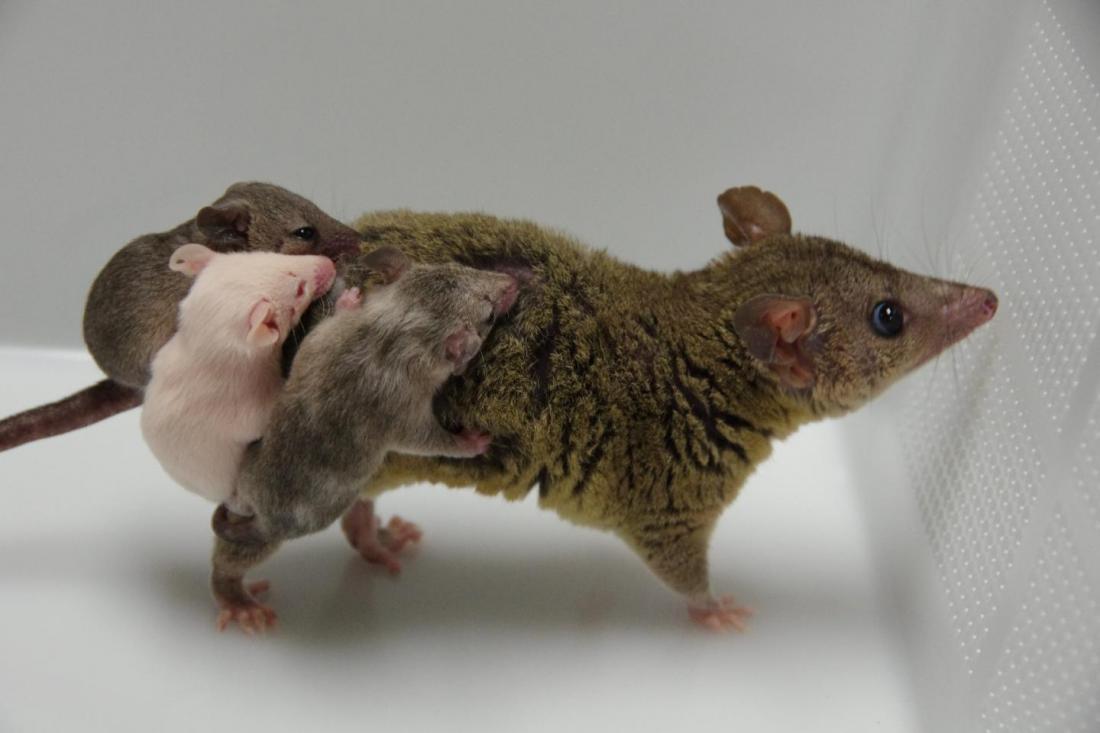Genome editing targeting a gene responsible for making body pigments resulted in albino offspring, suggesting that the genetic engineering was successful in marsupials.
Researchers at the RIKEN Center for Biosystems Dynamics Research (BDR) have succeeded in creating the first genetically engineered marsupial. This study, published in the scientific journal Current Biology, will contribute to deciphering the genetic background of unique characteristics observed only in marsupials.
Genetically modified animals, particularly mice and rats, are extremely important tools for researching biological processes. For example, researchers often silence genes to find out what their normal functions are. Since marsupials have unique characteristics, studying them requires developing a representative animal model. To date, the best option is the opossum, which is thought to be the ancestor of all marsupials. The first marsupial to have its entire genome sequenced, the opossum makes a good model animal because its size and breeding characteristics are similar to those of mice and rats.
Like other marsupials, the opossum has a variety of characteristics that are not found in other mammals. It develops without a functional placenta, and pups are born prematurely. Like humans, but not other non-marsupial mammals, it gets skin cancer simply by exposure to ultraviolet light. Also unlike other mammals, newborn opossum pups with spinal cord injuries have the ability to naturally heal themselves. Because of these unique characteristics, studying marsupial biology is gaining interest. However, it has been difficult to analyze their underlying genetics without established technology to genetically modify marsupials. Now, a research team led by Hiroshi Kiyonari at RIKEN BDR is taking advantage of new gene editing technology to get the ball rolling for opossum research.
Genome editing requires the systematic collection of fertilized eggs, as the solution for genome editing is injected into the fertilized eggs. Since opossums have a long estrus cycle and a strong sense of territoriality, it takes about a week for a couple to mate even if they live together, making it difficult to proceed with the experiment systematically. The research team administered a hormone used in mice and other laboratory animals to stimulate estrus in the females, and succeeded in significantly shortening the time required for mating.
Transplant of the embryo into a surrogate mother is required to generate a genome-edited fertilized egg. As is done in mice and rats, the researchers transferred the fertilized egg into the uterus of a fertile female opossum, and successfully obtained pups. This is the first case in which embryo transfer technology has been established in marsupials.
Usually the solution required for genome editing is injected into the fertilized egg using a fine needle. However, since the fertilized egg of the opossum is surrounded by a thick layer of proteins and a hard shell-like structure, the injection needle cannot penetrate it. “One of the tricks to our success,” Kiyonari explains, “was using a piezoelectronic element along with the needle, which allowed the needle to penetrate the hard shell coat and thick layer surrounding the egg. The piezo has thus made it possible to inject zygotes without significant damage.”
To confirm the overall methodology, the researchers targeted a gene responsible for making body pigments. When this gene is disrupted, pigment cannot be produced, and skin lacks color. Some of the offspring obtained from this experiment were albino, and their genes were inherited by the next generation, Thus, this represents the first successful gene editing in marsupials.
Now that the process has been established, researchers can focus on answering all their questions about marsupial biology. “Marsupials represent one of three extant mammalian subclasses with a number of unique characteristics not shared by other mammals. Having established the technology in this proof-of-concept experiment, future studies can create genetically modified marsupials that will impact the fields of mammalian embryology, genomic imprinting, reproduction, neurobiology, immunogenetics, cancer biology, and even comparative evolution,” Kiyonari says.
For more information, please contact:
Masataka Sasabe
RIKEN International Affairs Division
Email: [email protected]
About RIKEN
RIKEN is Japan's largest research institute for basic and applied research. Over 2500 papers by RIKEN researchers are published every year in leading scientific and technology journals covering a broad spectrum of disciplines including physics, chemistry, biology, engineering, and medical science. RIKEN's research environment and strong emphasis on interdisciplinary collaboration and globalization has earned a worldwide reputation for scientific excellence. Website | Facebook | Twitter
About the RIKEN Center for Biosystems Dynamics Research (BDR)
RIKEN Center for Biosystems Dynamics Research was established in 2018. It is the largest research center in RIKEN, with facilities in Yokohama and Hiroshima in addition to the Kobe and Osaka main campuses. The center views the life of an individual, from birth to death, as a dynamic process of development, maintenance and failure of complex systems of molecules, cells and organs. With an aim to elucidate the functions which support all stages of the life cycle, research and development is promoted to observe, reproduce and control biological phenomena, from molecular to organism levels. In addition to studying the development, growth, maturation, and aging of multicellular organisms, we apply the findings to regenerative medicine and diagnostic technology. The center aims to establish life science that contributes to the extension of the healthy lifespan, which is a major concern of Japan's aging society.
Website: http://www.bdr.riken.jp/en/



